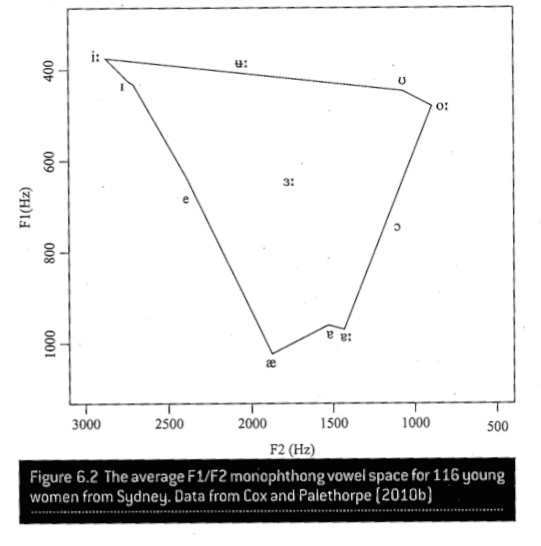The evolving story of how Australian English has been transcribed
Over the last half-century Australian phoneticians have used a set of symbols for the phonemic transcriptions of Australian English vowels, which were originally developed by Mitchell (1946) and popularised by Mitchell & Delbridge (1965). The Mitchell/Delbridge system was based fairly directly on the phonemes of British ‘Received Pronunciation’, and as a phonemic system (as opposed to a phonetic one) that was a reasonable choice because Australian English and RP had essentially the same set of about 44 phonemes.
However, more recent work by Clarke (1988), and Bernard and Mannell (1986), followed by Harrington, Cox and Evans (1997), has prompted a revised set of symbols for the phonemic transcription of Australian English. While a phonemic transcription system does not have to use symbols that represent vowels with phonetic accuracy, obviously it makes good sense to do so. To appreciate the need for a new phonemic system, it is important to understand that the Mitchell/Delbridge (henceforth MD) symbols first adopted in the 1940s had come to show a rather poor correlation with cardinal IPA vowels as Australian English was being spoken by 2000. To give one example, consider the vowel in the word ‘hoot’. In the MD system this was represented by /u/, and labeled a ‘high, back, rounded vowel’. But looking at the monophthong vowel chart below from Cox (2013), you can see that the same vowel, now represented as /ʉː/, is definitely not a ‘back vowel’. We would at least want to call it a ‘central vowel’, and note that its position is even further forward in vowel space than that of /æ/ which MD label a ‘front vowel’.
For these reasons the Harrington/Cox/Evans (henceforth HCE) system for the phonemic transcription of Australian English involves a set of symbols which more accurately relate the actual pronunciation of each vowel by an average speaker of General Australian English to the closest cardinal vowel. During the first decade of the 21C, both systems have been used, but increasingly Linguistics and Speech Pathology degrees within Australian universities are leaning towards the HCE system, and that is what we’ll be using here.
The HCE system uses the same symbols as MD for consonants, but involves considerable changes to the vowels. The table below lists words containing each of Australian English’s 20 phonemic vowels, contrasting the MD and HCE symbols.
| Mitchell / Debridge | Harrington/Cox/Evans | Example word | audio |
| i | iː | heed | |
| ɪ | ɪ | hid | |
| ɛ | e | head | |
| æ | æ | had | |
| a | ɐː | hard | |
| ʌ | ɐ | hut | |
| ɒ | ɔ | hot | |
| ɔ | oː | horde | |
| ʊ | ʊ | hood | |
| u | ʉː | hoot | |
| ɜ | ɜː | heard | |
| ə | ə | about | |
| eɪ | æɪ | hate | |
| aɪ | ɑe | height | |
| ɔɪ | oɪ | hoist | |
| aʊ | æɔ | howl | |
| oʊ | əʉ | hoed | |
| ɪə | ɪə | hear | |
| ɛə | eː | hair | |
| ʊə | ʊə | pure |
Differences between the systems
There are a few important differences between the MD and HCE systems:
▪ The MD system has 12 monophthong vowel phonemes and 8 diphthong vowel phonemes. However the HCE system has 13 monophthong vowel phonemes and 7 diphthong vowel phonemes. The difference revolves around the vowel we find in words like ‘bear, care, fair’. This vowel is represented as the diphthong /ɛə/ by MD, but as the long monophthong /eː/) in the HCE system. There is good evidence that this vowel is increasingly being monophthongised in current Australian English. Think about how you say ‘bear’. Can you feel centering tongue transition from [ɛ] or [e] to [ə], or does it feel as though your tongue is in a fixed position? Add a following syllable and say ‘bearing’ – now does it sound more like a monophthong? There is no ‘right’ answer here – this is a change in progress, but the HCE system better reflects the direction this change is heading in for most speakers of Australian English.
▪ A potential cause of confusion is the vowel symbol /ɔ/, which occurs in both systems but represents a different sound in each. In MD it is the sound in ‘port’, whereas in HCE it is the sound in ‘got’.
▪ The diphthong written as /ʊə/ represents the same vowel phoneme in both MD and HCE. This sound, however, can be quite varied in Australian English. Pay attention to words like ‘tour’. Some people say /tʊə/, others say this word with the long monophthong /toː/, and others break it into two syllables – something like /tʉːə/ or even /tʉːwə/.
▪ One of the advantages of the HCE system is that it captures the fact that some contrastive vowel phonemes in Australian English can usefully be thought of as long and short versions of the same tongue configuration. For example the vowels in ‘bed’ and ‘bared’ are represented in HCE by the same symbol, distinguished by the length diacritic, /bed/ and /be:d/. Similarly, the vowels in ‘bud’ and ‘bard’ are represented in HCE by the same symbol, distinguished by the length diacritic, /bɐd/ and /bɐ:d/. Note that the MD system does not reflect these ‘length pairings’.
